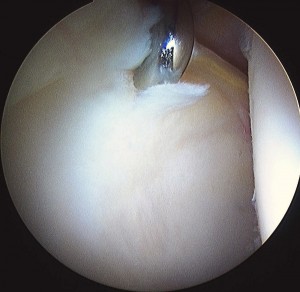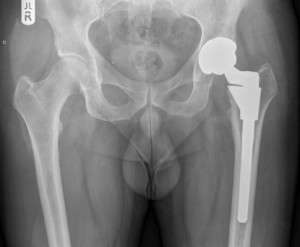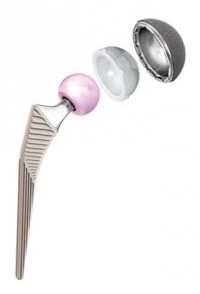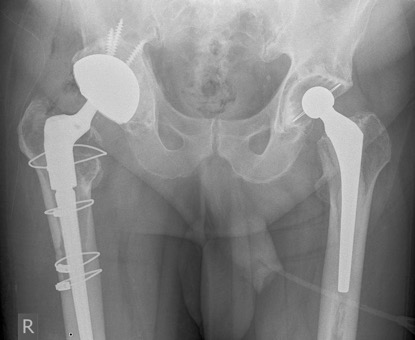
Hip
Select a treatment from the list below.
Performed by – Alastair Davidson, Azal Jalgaonkar, Richard Hargrove, Jonathan Hull, Zuhair Nawaz Seb Sturridge
This is keyhole surgery that enables us to look inside and treat a painful hip joint to improve pain and preserve the joint. Common symptoms that suggest there may be a problem inside the hip include pain in the groin, thigh or buttock; and mechanical symptoms such as clicking, catching and stiffness in the joint. Pain is commonly due to a torn cartilage, or ‘labrum’ that can be debrided or repaired.
What to expect
The procedure will be as a day case. You will require a general anaesthetic to relax your muscles so hip can be distracted with traction, to enable us to see inside it and introduce instruments to smooth off rough surfaces and remove loose pieces of cartilage that may be causing a problem. We use between two and four small (5mm) keyholes on the outside of the thigh.
On the day of surgery
Before surgery your consultant and anaesthetist will meet you in your room. The operation usually takes around 90 minutes to complete, but you may spend 30 minutes or more recovering in theatre before you return to the ward.
After a Hip Arthroscopy
You will wake up in recovery lying on your back. The hip area to be a little sore but there should be no severe pain. You will need to use crutches for a day or two and shouldn’t drive for ten days or so. There will be exercises to do with the physiotherapist but any impact exercises are not advised for a month. Because we need to pull hard on the leg to distract the hip during the operation, there may rarely be some numbness in the groin or thigh that should resolve within a few days or weeks.
Outcome
Most patients will benefit from hip arthroscopy, but there may be some conditions after which the improvement is only short-term and further surgery may be required. ‘We may ask your permission to enter information about your hip operation onto a national register managed by the British Hip Society. This is to help assess the outcome of your surgery and compare it with many other patients in the UK. It is completely confidential.
You will receive an email from the registry at 6 and 12 months post-op with a simple questionnaire to return. ‘

Keyhole appearance of torn labrum (rim) with some surface damage inside the hip socket
Performed by – Alastair Davidson, Azal Jalgaonkar, Richard Hargrove, Jonathan Hull, Zuhair Nawaz Andrew Perry, Seb Sturridge
A Total Hip Replacement (THR) is an excellent solution for a painful hip joint. It is one of most successful surgical procedures of the 21st century with over 95% of patients reporting good outcomes.
What to expect
Surgery is to improve pain, and therefore mobility and independence. Replacing a damaged hip involves making an incision along the outside of the upper thigh usually about 15-20 cms long. Whilst the incision is not in a particularly discreet area, the scar left by the procedure usually heals very well.
On the day of surgery
Before surgery your consultant and anaesthetist will meet you in your room. Surgery is usually under a spinal anaesthetic with some sedation so you can be asleep. The operation usually takes around 60 minutes to complete, but you may spend 30 minutes or more recovering in theatre before you return to the ward. You will wake up in recovery lying on your back. Your legs will still feel numb and weak until the anaesthetic wears off about 4 hours later. You will have some pain but this is often much less than you might expect, and the pain of the arthritis will have gone.
After the operation
The Physiotherapist will help you with some bed exercises, and progress you to standing and walking with crutches as you are able. Once you can move confidently with crutches you will be taught how to manage stairs so that when you leave hospital you will able to manage independently. Patients generally take two to five days to reach a point when they are fit to go home, depending their general fitness and their procedure.
After Discharge from hospital
Post-op physiotherapy will be arranged either at the hospital or at a local physiotherapy practice. This will continue for a few weeks during which you will see a constant improvement in your mobility as you gain strength and confidence. After a minimum of 4-6 weeks you may reduce down to one crutch while you are at home, but we would advise you stick to two when you are out of the house.
Lifespan of a hip replacement
Joint Reaction only use the best quality hip implants with a proven track record. It is important to understand that a hip replacement is artificial and will, eventually, wear out. During the lifespan of the THR you should live as normal a life as possible, but we would advise against running and high impact sports as these may cause the hip to wear faster.


Performed by – Alastair Davidson
Total Hip Replacement (THR) can now be performed using a computer guided robotic arm for assistance. The robotic arm acts as a guide to help the surgeon’s accuracy, the surgeon still performs the procedure and inserts the implants. This is a useful technology to optimise results and outcomes and help with precision of implant position and leg length. Joint Reaction surgeons have experience in performing this surgery and can discuss this technique with you to determine the best option for your hip replacement. This is not necessary in all cases but has some advantages. The hip replacement itself is the same top rated implant we use in conventional hip replacement, it is the surgical technique that varies. If you opt for robotic assisted hip replacement you do not have to prepare or rehab afterwards in any different way from a conventional THR and can fully weight bear after surgery.
Performed by – Azal Jalgaonkar, Richard Hargrove, Jonathan Hull, Zuhair Nawaz Andrew Perry, Seb Sturridge
Hip replacements can eventually loosen in the bone and become painful. This may be due to wearing down of the bearing surfaces within the hip or infection. Typically patients will feel pain in the groin or thigh, which starts gradually and is often worse on first standing up. This can be treated by removing the old implant and replacing it with a new one – revising the hip replacement.
What happens in surgery?
A revision operation is usually more complex than a first time hip replacement. The old components need to be removed and new, usually larger, ones will be put in their place. Sometimes the bone has been worn away and will need replacing with artificial or grafted bone, obtained from a registered bone bank. Bone graft is perfectly safe from infection risk and encourages what is left of the original bone to re-grow. The type of replacement used will vary and special components will sometimes be needed. Generally, we try to avoid using bone cement with revisions.
Revised Hip Replacement
If infection is the cause of the loosening two operations may be necessary. The first to remove the implant and any infected tissue. The second operation, some 6-8 weeks afterwards, to insert the new definitive hip. During the interval between operations you will be able to go home but will need crutches to get about. Patients generally find it surprisingly easy and comfortable during this time.
After the operation
As the operation is more complex you will be closely monitored in the first day or two, sometimes on the High Dependency Unit. You will probably require a catheter and will generally have to have a post-operative blood transfusion.
The recovery period is likely to be longer than the first replacement, mainly because the muscles take longer to heal as they have been repaired for a second time. You will need to use crutches for longer and it may take up to a year for optimal recovery to be achieved. There is a higher risk of dislocation, fracture, thrombosis and infection following revision surgery, but the overall results are still good with at least 70% of second hips lasting at least 10 years.


